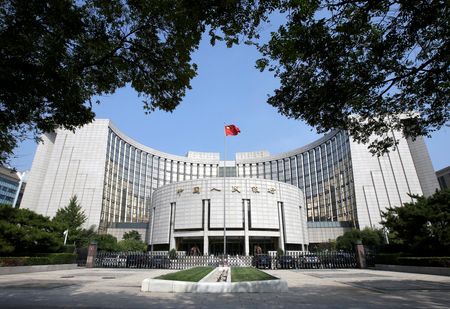SHANGHAI (Reuters) – China’s latest series of rate cuts show the central bank’s monetary framework has changed, analysts said, with the short-term repo rate becoming the primary signal and a diminished role for its medium-term lending facility (MLF).
CONTEXT
The People’s Bank of China (PBOC) surprised markets this week by first cutting several key rates including loan prime rate (LPR) and reverse repo rate on Monday. It then conducted an unscheduled MLF lending operation on Thursday, at steeply lower rates.
The sequence was a departure from the past, as MLF rate changes have historically been a precursor to LPR and deposit rate changes. The central bank also introduced a new cash management tool earlier this month in the form of temporary bond repurchase (repo) agreements and reverse repos.
WHY IT’S IMPORTANT
China’s central bank governor Pan Gongsheng said at the Lujiazui forum in June that he wanted the seven-day reverse repo rate to be the key benchmark.
Analysts say the PBOC is moving away from targeting money supply and towards the price of money. That means controlling short-term repo rates rather than the MLF, as the latter is used more to bridge funding shortfalls at banks.
Investors are closely tracking changes in the PBOC’s policy transmission mechanism amid heightened bond market volatility, as expectations rise for new steps to support a shaky economy and prevent too much cash being parked in safe-haven bonds.
BY THE NUMBERS
The PBOC lent one-year MLF loans this week at 2.30%, down 20 basis points from its previous MLF loan, its largest cut since April 2020.
Three days prior to that, the bank cut the seven-day reverse repo rate to 1.7% from 1.8%, and LPR by the same margin.
KEY QUOTES
“The arrangement of the MLF operation after the LPR further downplays the policy rate significance of the MLF, indicating that changes in the rate do not carry policy signal implications,” the PBOC-backed Financial News reported on Thursday, citing expert views.
“We are gradually shifting tracks, moving to the open market operations (OMO) rate as our benchmark interest rate, linking it to bond yields and the LPR,” said Liu Yu, chief economist at HuaXi Securities, in a webinar to investors.
(Reporting by Shanghai Newsroom; Editing by Vidya Ranganathan and Sam Holmes)










